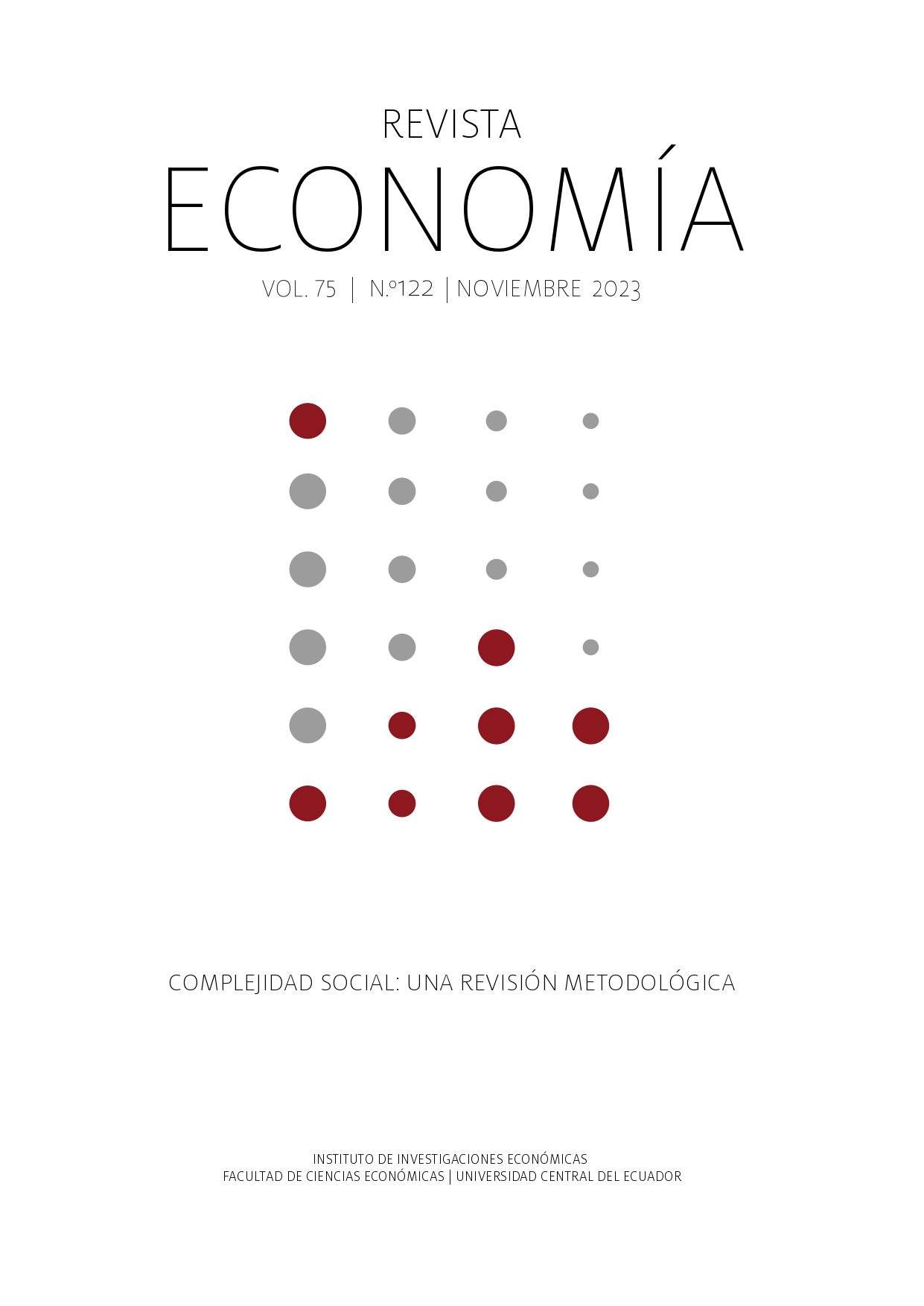Desbalances en las estructuras centro-periferia de la red de comercio internacional Una perspectiva desde el estructuralismo latinoamericano y la ciencia de la complejidad
Main Article Content
Abstract
This article examines hypotheses from Latin American Structuralism regarding the organization of International Trade. For this purpose, core-periphery hierarchies were created based on the Balance of Trade Power and were linked to the Balance of Trade, the Balance of Entropy (i.e. product diversity), and the Balance of Matter, with the last two being introduced in this study. The results partially support these hypotheses, showing that the core acts as a producer of entropy and a consumer of matter. However, no evidence was found of a trade surplus for the core, but it was found to have greater variability in its trade balance, suggesting greater flexibility in its economic management compared to the periphery.
Downloads
Article Details

This work is licensed under a Creative Commons Attribution-NonCommercial 4.0 International License.
The authors who publish in this journal accept the following conditions:
- The authors retain the copyright and assign to the Economics Magazine the right of the first publication, with the work registered under Creative Commons Attribution-NonCommercial 4.0, which enables third parties to redistribute, commercial or non-commercial, of what has been published as long as the article circulates completely and without changes.
- Authors can make other independent and additional contractual agreements for the distribution of the article published in this journal (for example, add it to an institutional repository or publish it in a book) as long as they clearly and clearly specify that the article was published for the first time. once in Revista Economía. In case of reproduction, a note similar to the one presented below must be included: This text was originally published in the Revista Economía No.…, volume…, number of pages, year of publication.
- Authors are suggested to publish their work on the internet (for example, on institutional or personal pages) of the final version published by Revista Economía since this can lead to greater and faster dissemination of the published article.
References
Aguilar-Monteverde, A. (1967). Teoría y política del desarrollo latinoamericano. Universidad Nacional Autónoma de México.
Cajas-Guijarro, J. (2023). Poder, crisis y periferias: cinco ensayos sobre la complejidad capitalista [Tesis de doctorado]. Facultad Latinoamericana de Ciencias Sociales.
Comín, F. C. (2014). Historia económica mundial. Alianza Editorial.
Delgado, C. et al. (2020). Business cycle synchronization: is it affected by inflation targeting credibility? SERIEs, 11(2), 157-177.
Farmer, J. D. (2012). Economics needs to treat the economy as a complex system. CRISIS Working Paper.
Fondo Monetario Internacional. (2006). Manual del índice de precios al consumidor: Teoría y práctica. International Monetary Fund.
Frankel, J. A., & Rose, A. K. (1998). The Endogeneity of the Optimum Currency Area Criteria. The Economic Journal, 108(449), 1009-1025.
Gala, P. et al. (2017). The Economic Commission for Latin America and the Caribbean (ECLAC) was right: scale-free complex networks and core-periphery patterns in world trade. Cambridge Journal of Economics, 42(3), 633-651.
Gaulier, G., & Zignago, S. (2010). Baci: international trade database at the product-level (the 1994-2007 version).
Hartmann, D. et al. (2020). International trade, development traps, and the core-periphery structure of income inequality. Economia, 21(2), 255-278.
Kostoska, O. et al. (2020). Core-periphery structure in sectoral international trade networks: A new approach to an old theory. PLoS ONE, 15(4), e0229547.
Lasky, M. J. (1998). Chain-type data and macro model properties: the DRI/McGraw-Hill experience. Journal of Economic and Social Measurement, 24(2), 83-108.
Pérez-Oviedo, W. et al. (2018). La integración latinoamericana desde un enfoque de redes. Cuadernos del CENDES, 35(98), 39-72.
Pérez-Oviedo, W. & Cajas-Guijarro, J. (2019). Midiendo la centralidad de los países y la integración comercial desde una perspectiva de red. Revista de Métodos Cuantitativos para la Economía y la Empresa, 26, 146-174.
Prebisch, R. (1949). El desarrollo de América Latina y algunos de sus principales problemas. CEPAL.
Prebisch, R. (1986). El desarrollo económico de la América Latina y algunos de sus principales problemas. Desarrollo económico, 479-502.
Taleb, N. N. (2007). The black swan: The impact of the highly improbable. Random House.
Teza, G. et al. (2021). Entropic measure unveils country competitiveness and product specialization in the world trade web. Scientific reports, 11(1), 10189.
Serrano, M. A., & Boguñá, M. (2003). Topology of the world trade web. Physical Review E, 68(1), 015101.
Smith, M., & Sarabi, Y. (2022). How does the behavior of the core differ from the periphery?–An international trade network analysis. Social Networks, 70, 1-15.
Wallerstein, I. (2006). Análisis de sistemas-mundo: una introducción. Siglo XXI Editores.
Zhou, M. et al. (2016). Structure and formation of top networks in international trade, 2001–2010. Social Networks, 44, 9-21.

